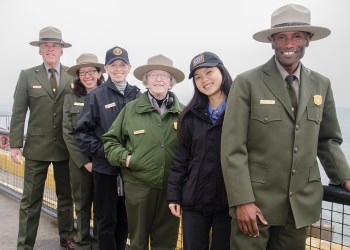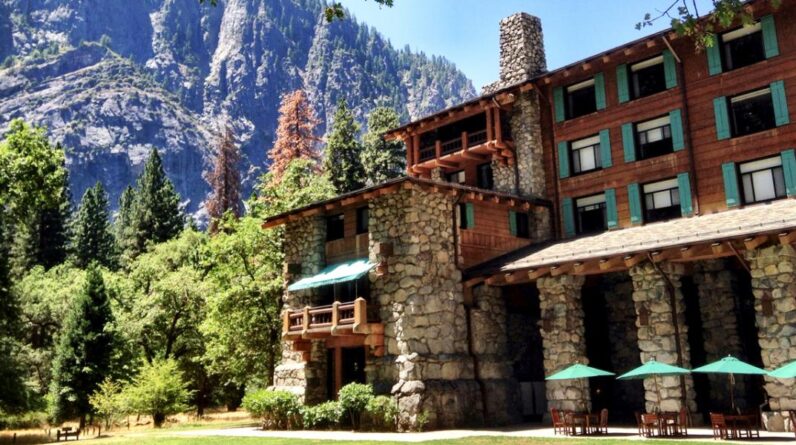
The National Park Service manages national parks, monuments, historic sites, and other protected areas. The National Park Service oversees and preserves a wide range of natural and cultural sites within the United States.
These include national parks, national monuments, historic sites, national historic parks, national lakeshores, and national seashores. The agency’s mission is to protect and manage these areas for future generations while providing opportunities for visitors to enjoy and learn from these unique places.
From the iconic Grand Canyon to the historic Independence Hall, the National Park Service is crucial in preserving the country’s natural and cultural heritage. With over 400 sites under their care, the National Park Service strives to balance conservation, education, and recreation to provide memorable experiences for all who visit.
National Park Service: An Overview
The National Park Service (NPS) is a vital organization responsible for managing the diverse natural and cultural resources throughout the United States. With a rich history dating back to its establishment in 1916, the NPS preserves and protects over 400 national parks, monuments, and historic sites that showcase the country’s remarkable heritage.
These protected areas encompass breathtaking landscapes, ancient ruins, historic landmarks, and national treasures, providing opportunities for education, recreation, and inspiration to millions of visitors annually. The NPS operates under the Department of the Interior, overseeing an extensive network of parks across various ecosystems, including forests, deserts, mountains, and coasts.
Through a dedicated team of park rangers, scientists, historians, and volunteers, the NPS ensures the preservation of these extraordinary locations for both present and future generations. The NPS plays a critical role in fostering a deeper appreciation for our natural and cultural heritage by continuously adapting to the changing needs of the environment and society.
Role And Mandate Of The National Park Service
The National Park Service (NPS) has a crucial role in managing and preserving natural and cultural resources within national parks. Their mandate includes protecting and conserving these resources for present and future generations.
NPS accomplishes this through various initiatives and programs. They strive to safeguard diverse ecosystems, maintain biodiversity, and restore endangered species. Additionally, NPS ensures visitor safety and education, promoting awareness and understanding of the parks’ ecological and historical significance.
The organization actively collaborates with local communities and stakeholders to facilitate responsible and sustainable use of park resources. Through scientific research and monitoring, NPS identifies potential environmental threats and implements appropriate management and mitigation strategies. Overall, the NPS plays a crucial role in preserving our national parks’ natural and cultural heritage for the enjoyment and benefit of all.
Types Of Parks Managed By The National Park Service
When it comes to managing natural and cultural resources, the National Park Service (NPS) plays a crucial role. National parks are one of the main types of parks managed by the NPS. These parks are known for their breathtaking landscapes, diverse ecosystems, and unique features. Examples of iconic national parks in the United States include Yellowstone, Yosemite, and the Grand Canyon.
National monuments are another type of park managed by the NPS. These monuments are established to preserve and celebrate specific areas’ historical and cultural significance. They provide visitors with insights into the past and allow them to connect with their heritage.
In addition to national parks and monuments, the NPS also manages national historic sites. These sites include important historical locations such as battlefields, landmarks, and archaeological sites. The NPS aims to preserve and interpret these sites, giving visitors a deeper understanding of our nation’s history.
Furthermore, the NPS is responsible for managing national recreation areas. These areas are designated to promote outdoor recreational activities such as hiking, camping, and boating. The NPS allows individuals and families to enjoy and appreciate the great outdoors by providing access to natural resources.
Natural Resources Managed By The National Park Service
The National Park Service manages a vast array of natural resources. This includes the preservation of flora and fauna, ensuring that these resources are protected and conserved. The National Park Service is crucial in safeguarding endangered species, working tirelessly to prevent their extinction and maintain biodiversity.
The service also focuses on the management of ecosystems within the national parks. This involves maintaining a delicate balance between various ecological components, such as forests, wetlands, and grasslands, to ensure their sustainability. Through their efforts, the National Park Service strives to protect and enhance the natural resources under its care, allowing future generations to experience and enjoy the wonders of these pristine environments.
Cultural Resources Managed By The National Park Service
Under the Cultural Resources Managed by the National Park Service, there are several key elements that the organization focuses on. These include historic buildings and structures, archaeological sites and artifacts, as well as cultural landscapes and heritage areas.
Regarding historic buildings and structures, the National Park Service works to preserve and protect these significant pieces of our collective history. They ensure that these buildings maintain their architectural integrity and historical value.
In addition, the National Park Service also manages archaeological sites and artifacts. They conduct surveys and excavations to uncover and preserve these valuable remnants of past civilizations. This helps to further our understanding of our cultural heritage.
Lastly, the National Park Service manages cultural landscapes and heritage areas. These areas include natural and man-made features deeply intertwined with a particular region’s history and culture.
Overall, the National Park Service is crucial in safeguarding our cultural resources, ensuring that future generations can explore and appreciate our rich heritage.
Visitor Services And Activities Offered By The National Park Service
Visitor services and activities offered by the National Park Service include interpretation and education programs, recreational opportunities, and facilities and amenities for visitors.
The National Park Service provides various interpretation and education programs to enhance visitors’ understanding and appreciation of the parks. These programs include guided tours, ranger talks, and informative exhibits highlighting the park’s unique natural and cultural features.
Regarding recreational opportunities, the National Park Service manages and maintains trails, campgrounds, picnic areas, and designated areas for hiking, fishing, boating, and wildlife-watching activities. Visitors can enjoy various outdoor activities that allow them to connect with nature and explore the parks’ diverse landscapes.
To cater to visitors’ needs, the National Park Service provides various facilities and amenities. These can include visitor centers, restrooms, parking areas, and accessible facilities to ensure that all visitors have a positive and inclusive experience while enjoying the parks.
Challenges Faced By The National Park Service
Managing national parks is challenging for the National Park Service (NPS) due to various factors. One of the key challenges is balancing preservation and visitor experience. NPS strives to protect the parks’ natural and cultural resources while providing an enjoyable experience for visitors. This requires careful planning and management to ensure the delicate balance between conservation and accessibility.
Another significant challenge NPS faces is climate change and its impact on park resources. Rising temperatures, changing precipitation patterns, and extreme weather events threaten the parks’ ecosystems, wildlife, and historic structures. NPS works towards understanding and mitigating these impacts to safeguard the future of the parks.
Funding and budgetary constraints are also a major challenge for NPS. Limited financial resources hinder the agency’s ability to perform necessary maintenance and improvements, affecting visitor facilities and infrastructure. NPS continually seeks innovative ways to secure funding and partnerships to address this issue.
Partnerships And Collaboration With Other Organizations
The National Park Service (NPS) manages a diverse range of natural and cultural resources across the United States. The agency recognizes the importance of partnerships and collaboration with other organizations to fulfill its stewardship responsibilities effectively.
One aspect of NPS’s collaborative efforts is working closely with local communities. The NPS recognizes that these communities are often deeply connected to the parks and can provide valuable insights and resources. By engaging in ongoing dialogue and cooperation, the NPS can better understand local communities’ unique needs and perspectives, allowing for more effective park management.
In addition to collaborating with local communities, the NPS also works with nonprofit organizations and agencies. This cooperation allows for the pooling of knowledge, resources, and expertise. Through partnerships with nonprofits and agencies, the NPS can expand its capacity to protect and preserve park resources while also fostering conservation initiatives on a larger scale.
| Benefits of Collaborative Efforts with Other Organizations |
|---|
| Enhanced understanding of local needs and perspectives |
| Increased access to resources and expertise |
| Expanded capacity for conservation initiatives |
Future Outlook Of The National Park Service
The National Park Service (NPS) manages and preserves over 400 sites across the United States. These sites include national parks, monuments, battlefields, and historic sites. With a focus on conservation and recreation, the NPS works towards safeguarding the nation’s natural and cultural resources for future generations.
Looking ahead, the NPS is committed to expanding its reach and establishing new parks to protect additional areas of significance. Technological advancements are crucial in park management, using remote sensing, GIS, and data analysis to improve conservation efforts and visitor experiences.
The NPS is also working to engage a diverse audience and address societal changes. Efforts are being made to ensure that everyone feels welcome in national parks, regardless of their race, gender, or background. Community partnerships, outreach programs, and interpretive initiatives are being implemented to make national parks more inclusive and accessible for all.
Frequently Asked Questions For What Does The National Park Service Manage
What Does The National Park Service Control?
The National Park Service controls and manages national parks, historic sites, monuments, and recreation areas throughout the United States.
What Does The National Park Service Manage Quizlet?
The National Park Service manages national parks, monuments, historic sites, and other protected areas.
Does The National Park Service Manage Ecosystems?
The National Park Service manages ecosystems within the national parks.
What Is The Role Of The National Park Service In Managing The Environment Who Put It In Place?
The National Park Service manages and protects the environment through various conservation efforts. It plays a crucial role in preserving and maintaining national parks, historic sites, and cultural landmarks.
Conclusion
To sum up, the National Park Service is responsible for protecting and preserving our nation’s most treasured landscapes. From majestic mountains to serene coastlines, they manage a vast array of natural and cultural sites. Through their dedicated efforts, they ensure that future generations can experience the beauty and wonder of these national treasures.
So, whether you seek adventure or solace, the National Park Service works tirelessly to ensure that these cherished places remain for all to enjoy.




